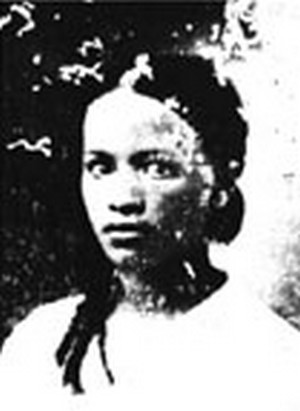By Paul McRandle
She was “beautiful as the flame of her thought,” to her daughter Ina. Her husband the poet, intellectual, and mayor of Fort-de-France Aimé Césaire wrote of her: “Ingenuous flames you who lick a rare heart.” André Breton, interned in Martinique on the way to New York, described her femine beauty “which has never appeared to me more dazzling than in a face of white ash and ambers.” Suzanne Césaire burned. And she could write: “Martinican poetry will be cannibal or it will not be.”

Breton’s introduction to her came about by way of a chance, wartime encounter. Having left Marseille with Jacqueline and their daughter Aube, in late March, 1941 on a filthy and overcrowded ship, they arrived in Martinique only to be held in a camp by the Vichy authorities. On a day when he was allowed into Fort-de-France, he records:
“This town itself held onto nothing; it seemed deprived of its essential organs. Trade, all conducted in shop windows, took on a disturbing, hypothetical character. Movement was a little slower than necessary, the noise too clear, as though coming through the stranded wrecks. In the pure air the continuous ringing of a distant alarm bell.
"It was in these circumstances that I chanced, while buying a ribbon for my daughter, to thumb through a publication lying in the haberdashery. Unpretentious in appearance, it was the first issue of a review entitled Tropiques which had just appeared in Fort-de-France.”
Surrealism was already there to greet him. The following day Breton met Aimé and Suzanne Césaire, and Suzanne noted her impressions of him in a piece which appeared in the third issue of Tropiques. She writes of the “freedom to do and undo” and took from him the demand for freedom. Two years later she wrote that “far from contradicting, diminishing, or diverting our revolutionary feeling for life, surrealism shored it up. It nourished in us an impatient strength, endlessly sustaining this massive army of negations.”
Among the essays she wrote, “The Great Camouflage” stands out with its historic vision of Martinique—sweeping change is signaled from the start in a cyclone hurtling across the Antilles. She writes of the arrival of new authorities:
“On the beach there were some ‘metropolitan functionaries.’ They were landed there, without conviction, ready to take off at the first signal. The new arrivals are hardly adapting to our 'old French territories.’ When they lean over the malefic mirror of the Caribbean, they see therein the delirious reflection of themselves. They dare not recognize themselves in this ambiguous being, the Antillean. They know that the métis have a part of their blood, that they are, like them, of Western civilization. Of course, it is understood that the 'metropolitans’ are unaware of the prejudice of color. But colored descendants fill them with fear, in spite of the smile exchanged. They were not expecting this strange bourgeoning of their blood. Perhaps they would like not to respond to the Antillean heir who shouts, but does not shout out "my father.” However one will have to deal with these unanticipated boys, these charming girls. One must govern these unruly people.“
Misrecognition and miscegenation are elementary to the great camouflage. And Césaire claimed her right to a position in French culture as the cannibal these metropolitan functionaries wouldn’t admit they saw—she certainly possessed a consuming intellect.
In any case, despite the camouflage, the Vichy powers made publishing Tropiques a hazardous enterprise, banning it for a period before their withdrawal in 1943. And under the corrupt powers ruling the island, all of the editors faced the threat of imprisonment if not worse. After the war, she taught while Aimé Césaire won an the election for mayor of Fort-de-France on the communist ticket and was also elected deputy to the French National Assembly. He used this position to improve the status former colonies, transforming them into departments equivalent to those in mainland France. Suzanne went on to publish her play Aurore de la liberté and returned to France in 1955 to teach literature.
Sources
The Great Camouflage: Writings of Dissent (1941-1945) / Suzanne Césaire, edited by Daniel Maximin, translated by Keith L. Walker (Wesleyan University Press, 2012) "On the beach…” quoted from p. 43.
“A Great Black Poet: Aimé Césaire” in What is Surrealism? Selected Writings by André Breton, edited by Franklin Rosemont (Monad Press, 1978) “This town itself…” quoted from p. 230.
Black, Brown, & Beige: Surrealist Writings from Africa and the Diaspora, edited by Franklin Rosemont and Robin D. G. Kelley (University of Texas Press, 2009)
Martinique Charmeuse de Serpents by André Breton and André Masson, Ouevres Complètes, vol III (Éditions Gallimard, 1999). This title has been translated into English by David W. Seamon as Martinique Snake Charmer (University of Texas, 2008)
Tropiques: 1941-1945, Éditions Jean-Michel Place, 1978
 miraclenwaizu liked this
miraclenwaizu liked this modern-virago liked this
gap01 liked this
tanomuro liked this
 moralwounds liked this
moralwounds liked this  weil-weil-lautre liked this
weil-weil-lautre liked this getradified reblogged this from surrealistnyc
sidiklisaziye liked this
elleblack liked this
edwordsmyth liked this
yesyes reblogged this from surrealistnyc
yesyes liked this
 emailsent liked this
emailsent liked this xicanxmaroon reblogged this from lostcoherence
thepatternist-blog liked this
bittermelon-and-me reblogged this from lostcoherence
catlovesmocalike liked this
lostcoherence reblogged this from surrealistnyc
janitordreams liked this
loversofdunntre-blog reblogged this from surrealistnyc
amysall liked this
lalapeepo liked this
ghoulchantsister liked this
digitaldesperados reblogged this from surrealistnyc
digitaldesperados liked this
luminousvelocity liked this
lhbloggish reblogged this from surrealistnyc
lhbloggish liked this
 viliere liked this
viliere liked this  khimaerasworld liked this
khimaerasworld liked this surrealistnyc posted this
- Show more notes